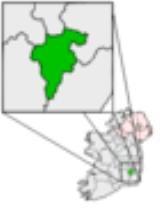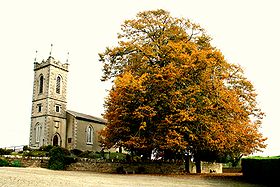
Clonegal
Encyclopedia
Clonegal, officially Clonegall (icon ; ), is a village in the southeast of County Carlow
, Ireland
. It is in a rural setting, 5 km from Bunclody
, County Wexford
, 22 km from Carlow
and 17 km from the proposed interchange of the N9 and N80
roads at Rathcrogue. It is just over a mile north of where the River Slaney
and the River Derry
meet. Clonegal has a much smaller "twin" village across the River Derry
in County Wexford
, Watch House Village
.
The town is served by a primary school, and is central to a thriving agricultural hinterland, although it has little business development. Further housing development is imminent.
Cluain na nGall or Meadow of the Foreigner. This could have originated from when Cromwell
’s soldiers, during the Irish Confederate Wars
, fought the Irish in the village in 1650 after which all Irish surviving males were massacred. Others contend that it came from foreign students who came to study in a monastery near the village.

County Carlow
County Carlow is a county in Ireland. It is part of the South-East Region and is also located in the province of Leinster. It is named after the town of Carlow, which lies on the River Barrow. Carlow County Council is the local authority for the county...
, Ireland
Republic of Ireland
Ireland , described as the Republic of Ireland , is a sovereign state in Europe occupying approximately five-sixths of the island of the same name. Its capital is Dublin. Ireland, which had a population of 4.58 million in 2011, is a constitutional republic governed as a parliamentary democracy,...
. It is in a rural setting, 5 km from Bunclody
Bunclody
Bunclody is a small town located on the River Slaney, on the border between counties Wexford and Carlow, Ireland. The R746 regional road intersects the N80 in the centre of the town. It is a picturesque town near the foot of Mount Leinster. Most of the town is situated in County Wexford...
, County Wexford
County Wexford
County Wexford is a county in Ireland. It is part of the South-East Region and is also located in the province of Leinster. It is named after the town of Wexford. In pre-Norman times it was part of the Kingdom of Uí Cheinnselaig, whose capital was at Ferns. Wexford County Council is the local...
, 22 km from Carlow
Carlow
Carlow is the county town of County Carlow in Ireland. It is situated in the south-east of Ireland, 84 km from Dublin. County Carlow is the second smallest county in Ireland by area, however Carlow Town is the 14th largest urban area in Ireland by population according to the 2006 census. The...
and 17 km from the proposed interchange of the N9 and N80
N80 road (Ireland)
The N80 road is a national secondary road in Ireland that runs southeastwards from its junction with the N52 and R443 in the town of Tullamore in County Offaly, to the N11 at Ballynahallin, just north of Enniscorthy in County Wexford, a distance of 116 km...
roads at Rathcrogue. It is just over a mile north of where the River Slaney
River Slaney
The Slaney is a river in the southeast of Ireland. It rises on Lugnaquilla Mountain in the western Wicklow Mountains and flows west and then south through counties Wicklow, Carlow and Wexford, before entering St George's Channel in the Irish Sea at Wexford town...
and the River Derry
River Derry
The Derry River rises just south of Hacketstown, County Carlow. It flows southeast to Tinahely, being accompanied by the R747 regional road for the distance....
meet. Clonegal has a much smaller "twin" village across the River Derry
River Derry
The Derry River rises just south of Hacketstown, County Carlow. It flows southeast to Tinahely, being accompanied by the R747 regional road for the distance....
in County Wexford
County Wexford
County Wexford is a county in Ireland. It is part of the South-East Region and is also located in the province of Leinster. It is named after the town of Wexford. In pre-Norman times it was part of the Kingdom of Uí Cheinnselaig, whose capital was at Ferns. Wexford County Council is the local...
, Watch House Village
Watch House Village
Watch House Village is a small village in County Wexford, Ireland, on the River Derry. It is a twin village of the much larger Clonegal in County Carlow on the other side of the river, which forms the county boundary.-History:...
.
The town is served by a primary school, and is central to a thriving agricultural hinterland, although it has little business development. Further housing development is imminent.
Name
The name Clonegal comes from the IrishIrish language
Irish , also known as Irish Gaelic, is a Goidelic language of the Indo-European language family, originating in Ireland and historically spoken by the Irish people. Irish is now spoken as a first language by a minority of Irish people, as well as being a second language of a larger proportion of...
Cluain na nGall or Meadow of the Foreigner. This could have originated from when Cromwell
Oliver Cromwell
Oliver Cromwell was an English military and political leader who overthrew the English monarchy and temporarily turned England into a republican Commonwealth, and served as Lord Protector of England, Scotland, and Ireland....
’s soldiers, during the Irish Confederate Wars
Irish Confederate Wars
This article is concerned with the military history of Ireland from 1641-53. For the political context of this conflict, see Confederate Ireland....
, fought the Irish in the village in 1650 after which all Irish surviving males were massacred. Others contend that it came from foreign students who came to study in a monastery near the village.
Demographics
According to the 2006 Census, Clonegal had a population of approximately 280, an increase of 20% since the 2002 Census.History
It once had eleven malt houses in and around the village, along with a wool and corn store, a police station and other shops.Places of interest
- Huntington CastleHuntington Castle, ClonegalHuntington Castle, also known as Clonegal Castle, is a castle in Clonegal, County Carlow, Ireland.The structure was originally a "plantation castle",, used for defensive purposes during the plantation of the area in the early 17th century. The original tower house, which served as a garrison, was...
(also known as Clonegal Castle) was built on the site of an old manor house by the Esmonds in 1625. It is one of the few castles still lived in by direct descendants of the builder. In 1588 Queen Elizabeth IElizabeth I of EnglandElizabeth I was queen regnant of England and Ireland from 17 November 1558 until her death. Sometimes called The Virgin Queen, Gloriana, or Good Queen Bess, Elizabeth was the fifth and last monarch of the Tudor dynasty...
’s forces had captured the area and it was given to the Netterville family who in turn gave it to the Esmonds.

- St. Brigid’s Church - the present church replaced the old Roman CatholicRoman Catholic ChurchThe Catholic Church, also known as the Roman Catholic Church, is the world's largest Christian church, with over a billion members. Led by the Pope, it defines its mission as spreading the gospel of Jesus Christ, administering the sacraments and exercising charity...
church which was built of mud walls and had a thatched roof. It is a barn type construction, built in 1824 around the old church. When the new building was completed the old building was taken out through the doors of the new church. - St. Fiaacs Church is a Church of IrelandChurch of IrelandThe Church of Ireland is an autonomous province of the Anglican Communion. The church operates in all parts of Ireland and is the second largest religious body on the island after the Roman Catholic Church...
church situated on a slope to the north of the village. It was originally founded about the time of Saint PatrickSaint PatrickSaint Patrick was a Romano-Briton and Christian missionary, who is the most generally recognized patron saint of Ireland or the Apostle of Ireland, although Brigid of Kildare and Colmcille are also formally patron saints....
on a DunDunDun is now used both as a generic term for a fort and also for a specific variety of Atlantic roundhouse...
surrounded by a deep moat enclosed by a rathRingfortRingforts are circular fortified settlements that were mostly built during the Iron Age , although some were built as late as the Early Middle Ages . They are found in Northern Europe, especially in Ireland...
, and was believed to have been the residence of an ancient chieftain in the 6th century. - The Old Rectory is now a private house, but was the residence of John DeRenzy, commander of the yeomen in Clonegal during the Irish Rebellion of 1798Irish Rebellion of 1798The Irish Rebellion of 1798 , also known as the United Irishmen Rebellion , was an uprising in 1798, lasting several months, against British rule in Ireland...
. Prisoners to be hanged were brought to a yard just above the rectory. The archway leading into this yard is known as the Hanging Arch and is marked by a stone slab on the wall.
People
It was the birthplace of Patrick O'Donoghue, the 19th century rish Nationalist revolutionary and journalist.See also
- List of towns and villages in Ireland
External links
- Clonegal
- Clonegal Castle
- A Visit to Clonegal Castle
- Clonegal Castle gallery at Fellowship of IsisFellowship of IsisThe Fellowship of Isis is an international spiritual organization devoted to promoting awareness of the Goddess. It is dedicated specifically to the Egyptian goddess Isis because the FOI co-founders believed Isis best represented the energies of the dawning Aquarian Age...

